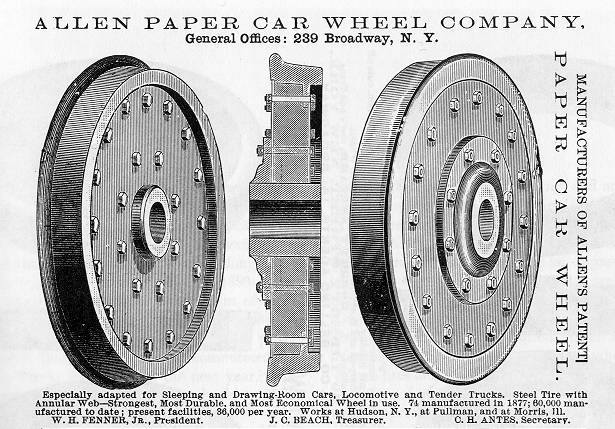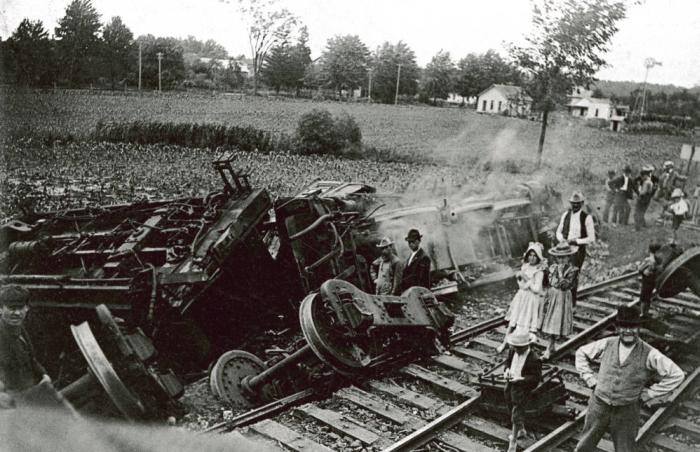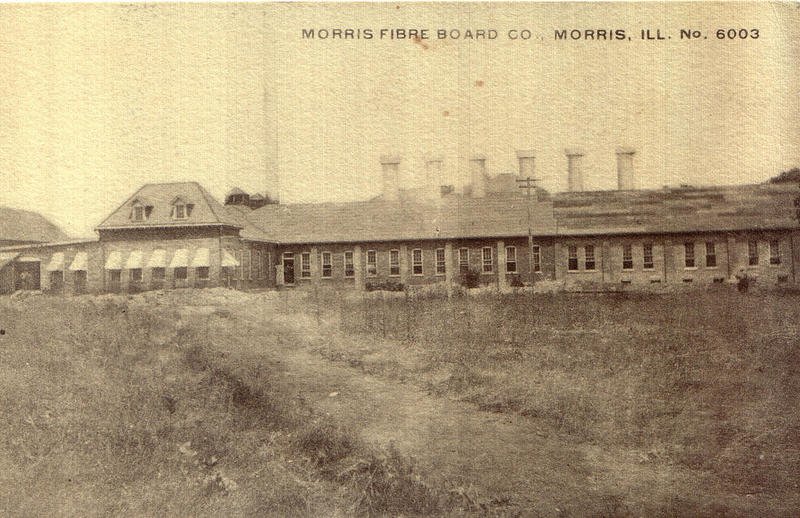paper car wheel on:
[Wikipedia]
[Google]
[Amazon]
 Paper car wheels were composite
Paper car wheels were composite
''Engines of Our Enginuity, No. 758: Paper railroad wheels.''
/ref> The center was made of compressed paper held between two plate-iron disks. Their ability to damp rail/wheel noise resulted in a quiet and smooth ride for the passengers of North American Pullman dining and sleeping cars.
 Paper car wheels were invented by the locomotive engineer Richard N. Allen (1827–1890), who set up a company with his brother-in-law in 1867, producing paper from straw. They damped vibrations much better than conventional cast-iron railway wheels, which transmitted all imperfections of the track into the car above it, making train rides noisy and uncomfortable. Paper wheels were especially used in Pullman dining and sleeping cars, which were built and operated by Pullman, to give passengers in these cars a quieter, vibration-free ride. Due to the composite construction, the wheels would fail faster than the all-metal wheels, which caused derailments. In 1915 the
Paper car wheels were invented by the locomotive engineer Richard N. Allen (1827–1890), who set up a company with his brother-in-law in 1867, producing paper from straw. They damped vibrations much better than conventional cast-iron railway wheels, which transmitted all imperfections of the track into the car above it, making train rides noisy and uncomfortable. Paper wheels were especially used in Pullman dining and sleeping cars, which were built and operated by Pullman, to give passengers in these cars a quieter, vibration-free ride. Due to the composite construction, the wheels would fail faster than the all-metal wheels, which caused derailments. In 1915 the
''Paper Passenger Car Wheels.''
In: ''The Proto Journal'', Volume 4, No 2.
 The Allen Paper Car Wheel Works was initially based on East North Street in
The Allen Paper Car Wheel Works was initially based on East North Street in
In: ''The Herald-News'', 18 October 2017. By 1881, the Allen Paper Car Wheel Co. operated workshops in New York and Chicago, but maintained its processing plant in Morris. Each workshop employed approximately 80 men and produced more than 24 wheels a day. Thus the company produced and sold thousands of wheels each year. In 1886 the company announced it had 60,000 wheels in service. In 1893 it had sold 115,000. The Allen Paper Car Wheel Works operated until 1890, when they were transferred to John N. Bunnell and changed their name to the American Straw Board Co. Subsequently, the business and plant were leased, sold and restructured, and operated for the next two decades under different names, including the Morris Box Board Co. In October 1915, the company was restructured and incorporated as the Morris Paper Mills. By the 1920s, the paper mill was one of the largest employers in Morris, producing cardboard boxes of various shapes, sizes, and colors that were shipped throughout the US.
 The company John Brown & Co in
The company John Brown & Co in ''Allen's elastische Eisenbahn-Wagenräder.''
In: Stummer's Ingenieur: internationales Organ für d. Gesamtgebiet d. techn. Wissens u. Repertorium d. hervorragendsten ausländ. Fachjournale, No. 95, Vol. 4, Fromme, 1875, pp. 189-190.
In: ''Polytechnisches Journal.'' 1881, Band 242, S. 68. The wheels used in Saarbrücken were constructed in the manner of wooden
US Patent No 89,908
11 May 1869, R.N. Allen & L.W. Kimball: Basic patent
US Patent No 128,939
16 July 1872, Richard N. Allen: Improved construction of wheel * US Patent No RE 7,142, 30 May 1876, Richard N. Allen: Reissue of 89,908 * US Patent No 182,789, 3 October 1876. Richard N. Allen & Albert B. Pullman: Car wheels connecting tire and hub with a variety of “elastic” materials other than paper.
 Paper car wheels were composite
Paper car wheels were composite wheels
A wheel is a circular component that is intended to rotate on an axle bearing. The wheel is one of the key components of the wheel and axle which is one of the six simple machines. Wheels, in conjunction with axles, allow heavy objects to be ...
of railway carriage
A railroad car, railcar (American and Canadian English), railway wagon, railway carriage, railway truck, railwagon, railcarriage or railtruck (British English and UIC), also called a train car, train wagon, train carriage or train truck, is a ...
s, made from a wrought iron
Wrought iron is an iron alloy with a very low carbon content (less than 0.08%) in contrast to that of cast iron (2.1% to 4%). It is a semi-fused mass of iron with fibrous slag Inclusion (mineral), inclusions (up to 2% by weight), which give it a ...
or steel
Steel is an alloy made up of iron with added carbon to improve its strength and fracture resistance compared to other forms of iron. Many other elements may be present or added. Stainless steels that are corrosion- and oxidation-resistant ty ...
rim bolted to an iron hub with an interlayer of laminated paper.John H. Lienhard''Engines of Our Enginuity, No. 758: Paper railroad wheels.''
/ref> The center was made of compressed paper held between two plate-iron disks. Their ability to damp rail/wheel noise resulted in a quiet and smooth ride for the passengers of North American Pullman dining and sleeping cars.
Concept
 Paper car wheels were invented by the locomotive engineer Richard N. Allen (1827–1890), who set up a company with his brother-in-law in 1867, producing paper from straw. They damped vibrations much better than conventional cast-iron railway wheels, which transmitted all imperfections of the track into the car above it, making train rides noisy and uncomfortable. Paper wheels were especially used in Pullman dining and sleeping cars, which were built and operated by Pullman, to give passengers in these cars a quieter, vibration-free ride. Due to the composite construction, the wheels would fail faster than the all-metal wheels, which caused derailments. In 1915 the
Paper car wheels were invented by the locomotive engineer Richard N. Allen (1827–1890), who set up a company with his brother-in-law in 1867, producing paper from straw. They damped vibrations much better than conventional cast-iron railway wheels, which transmitted all imperfections of the track into the car above it, making train rides noisy and uncomfortable. Paper wheels were especially used in Pullman dining and sleeping cars, which were built and operated by Pullman, to give passengers in these cars a quieter, vibration-free ride. Due to the composite construction, the wheels would fail faster than the all-metal wheels, which caused derailments. In 1915 the Interstate Commerce Commission
The Interstate Commerce Commission (ICC) was a regulatory agency in the United States created by the Interstate Commerce Act of 1887. The agency's original purpose was to regulate railroads (and later trucking) to ensure fair rates, to eliminat ...
, which regulated U.S. railroads, declared paper car wheels to be unsafe, and they went out of use on railroad passenger cars in the United States.
Manufacture
The construction process involved the bonding of 200 circular sheets of paper, as follows. Sets of three circular sheets were bonded into a "sandwich" using a flour-based glue. Additional "sandwiches" were then constructed and placed atop one another to make a high stack. This stack was placed in a 650-tonhydraulic press
A hydraulic press is a machine press using a hydraulic cylinder to generate a compressive force. It uses the hydraulic equivalent of a mechanical lever, and was also known as a Bramah press after the inventor, Joseph Bramah, of England. He inven ...
for three hours. The circular compound disks were then dried and cured for six to eight weeks, leaving no moisture in them. After curing, the compound disks were turned in a lathe
A lathe () is a machine tool that rotates a workpiece about an axis of rotation to perform various operations such as cutting, sanding, knurling, drilling, deformation, facing, and turning, with tools that are applied to the workpiece to c ...
to the appropriate size, and 24 or more bolt holes were drilled in them. These compound disks formed the center of each wheel, to which was added a cast-iron hub and steel rim bolted to thick protective metal plates on either side of the paper center. With the bolts tightened, the paper center became a "solid, dense, compressed, composite structure" which could support the weight of the carriages.John E. Eichman, Sr''Paper Passenger Car Wheels.''
In: ''The Proto Journal'', Volume 4, No 2.
United States
 The Allen Paper Car Wheel Works was initially based on East North Street in
The Allen Paper Car Wheel Works was initially based on East North Street in Morris, Illinois
Morris is a city in and the county seat of Grundy County, Illinois, United States and part of the southwest Chicago metropolitan area. The population was estimated at 15,053 in 2019.
Description
Morris is the Grundy County seat and has a larg ...
, while its general office was on 239 Broadway
Broadway may refer to:
Theatre
* Broadway Theatre (disambiguation)
* Broadway theatre, theatrical productions in professional theatres near Broadway, Manhattan, New York City, U.S.
** Broadway (Manhattan), the street
**Broadway Theatre (53rd Stree ...
, New York
New York most commonly refers to:
* New York City, the most populous city in the United States, located in the state of New York
* New York (state), a state in the northeastern United States
New York may also refer to:
Film and television
* '' ...
. The company's principal customer was the Pullman Palace Car Company
The Pullman Company, founded by George Pullman, was a manufacturer of railroad cars in the mid-to-late 19th century through the first half of the 20th century, during the boom of railroads in the United States. Through rapid late-19th century ...
in Chicago
(''City in a Garden''); I Will
, image_map =
, map_caption = Interactive Map of Chicago
, coordinates =
, coordinates_footnotes =
, subdivision_type = Country
, subdivision_name ...
which, after testing and optimising the wheel, had placed their first order for 100 wheels in 1871. Subsequently, the main plant was established at South Bay in Hudson, New York
Hudson is a city and the county seat of Columbia County, New York, United States. As of the 2020 census, it had a population of 5,894. Located on the east side of the Hudson River and 120 miles from the Atlantic Ocean, it was named for the rive ...
, in 1873, and eventually relocated onto the site of Pullman's Chicago works.''Then & Now: Morris Paper Mills – Morris.''In: ''The Herald-News'', 18 October 2017. By 1881, the Allen Paper Car Wheel Co. operated workshops in New York and Chicago, but maintained its processing plant in Morris. Each workshop employed approximately 80 men and produced more than 24 wheels a day. Thus the company produced and sold thousands of wheels each year. In 1886 the company announced it had 60,000 wheels in service. In 1893 it had sold 115,000. The Allen Paper Car Wheel Works operated until 1890, when they were transferred to John N. Bunnell and changed their name to the American Straw Board Co. Subsequently, the business and plant were leased, sold and restructured, and operated for the next two decades under different names, including the Morris Box Board Co. In October 1915, the company was restructured and incorporated as the Morris Paper Mills. By the 1920s, the paper mill was one of the largest employers in Morris, producing cardboard boxes of various shapes, sizes, and colors that were shipped throughout the US.
United Kingdom
 The company John Brown & Co in
The company John Brown & Co in Sheffield
Sheffield is a city status in the United Kingdom, city in South Yorkshire, England, whose name derives from the River Sheaf which runs through it. The city serves as the administrative centre of the City of Sheffield. It is Historic counties o ...
, England
England is a country that is part of the United Kingdom. It shares land borders with Wales to its west and Scotland to its north. The Irish Sea lies northwest and the Celtic Sea to the southwest. It is separated from continental Europe b ...
, came to an agreement with the inventor on the manufacture of paper wheels in Europe. It installed the necessary machines by October 1875, so that production was expected to start in due course.In: Stummer's Ingenieur: internationales Organ für d. Gesamtgebiet d. techn. Wissens u. Repertorium d. hervorragendsten ausländ. Fachjournale, No. 95, Vol. 4, Fromme, 1875, pp. 189-190.
Germany
As proposed by the Master Machine Builder Finckbein inSaarbrücken
Saarbrücken (; french: link=no, Sarrebruck ; Rhine Franconian: ''Saarbrigge'' ; lb, Saarbrécken ; lat, Saravipons, lit=The Bridge(s) across the Saar river) is the capital and largest city of the state of Saarland, Germany. Saarbrücken is S ...
- St. Johann and the Master Craftsman Caesar of the Reichseisenbahn, the oilboard and lacquerware factory of Gebrüder Adt in Forbach
Forbach ( , , ; gsw, Fuerboch) is a commune in the French department of Moselle, northeastern French region of Grand Est.
It is located on the German border approximately 15 minutes from the center of Saarbrücken, Germany, with which it const ...
produced a paper pulp suitable for railway car wheels after various tests. With the permission of the Royal Railway Administration in Frankfurt a. M., wheelsets with paper discs were manufactured in the main railway workshop in Saarbrücken and in the railway car wheels factory of the van der Zypen brothers in Deutz and then put into use. Such wheelsets with paper pulp discs were in regular service on wagons for a long time. They held perfectly and showed a very smooth running while driving without making any annoying noises.''Eisenbahnwagenräder aus Papier.''In: ''Polytechnisches Journal.'' 1881, Band 242, S. 68. The wheels used in Saarbrücken were constructed in the manner of wooden
Mansell wheel
The Mansell Wheel is a railway wheel patented by Richard Mansell, the Carriage and Wagon superintendent of the South Eastern Railway in the UK. The design was created in the 1840s and was eventually widely used on passenger railway stock in the ...
s, with the wheel tire being placed on the paper disc and the hub in it by means of strong hydraulic pressure, while the tires of the American paper wheels were provided with an inner attachment against which the paper disc was pressed and to which it was connected by bolts. Practice has shown that tires with such an inner approach, apparently due to the uneven mass distribution, cracked from the inside to the outside, so that the advantage of reinforcing the tires was lost and an opposite result was achieved. The tire in conventional Mansell wheels with wooden discs could slip on the wooden disc when the tire was warmed up during braking. In the wheels designed in Saarbrücken, four iron dowels were therefore inserted on each side between the tire and the Mansell ring, which prevented the wheel tires from turning during braking.
Patents
US Patent No 89,908
11 May 1869, R.N. Allen & L.W. Kimball: Basic patent
US Patent No 128,939
16 July 1872, Richard N. Allen: Improved construction of wheel * US Patent No RE 7,142, 30 May 1876, Richard N. Allen: Reissue of 89,908 * US Patent No 182,789, 3 October 1876. Richard N. Allen & Albert B. Pullman: Car wheels connecting tire and hub with a variety of “elastic” materials other than paper.
References
{{reflist, 30em Rail transport Wheels Paper Pullman Company Train wheels